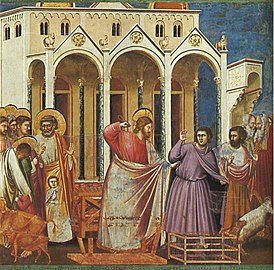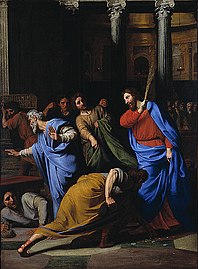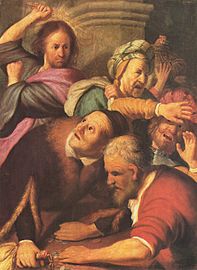
The Gospel of Mark is the second of the four canonical gospels and one of the three synoptic Gospels. It tells of the ministry of Jesus from his baptism by John the Baptist to his death, the burial of his body, and the discovery of his empty tomb. It portrays Jesus as a teacher, an exorcist, a healer, and a miracle worker, though it does not mention a miraculous birth or divine pre-existence. He refers to himself as the Son of Man. He is called the Son of God but keeps his messianic nature secret; even his disciples fail to understand him. All this is in keeping with the Christian interpretation of prophecy, which is believed to foretell the fate of the messiah as suffering servant.

The Gospel of Matthew is the first book of the New Testament of the Bible and one of the three synoptic Gospels. It tells how Israel's Messiah, Jesus, comes to his people but is rejected by them and how, after his resurrection, he sends the disciples to the gentiles instead. Matthew wishes to emphasize that the Jewish tradition should not be lost in a church that was increasingly becoming gentile. The gospel reflects the struggles and conflicts between the evangelist's community and the other Jews, particularly with its sharp criticism of the scribes and Pharisees with the position that through their rejection of Christ, the Kingdom of God has been taken away from them and given instead to the church.

The Gospel of John is the fourth of the four canonical gospels in the New Testament. It contains a highly schematic account of the ministry of Jesus, with seven "signs" culminating in the raising of Lazarus and seven "I am" discourses culminating in Thomas' proclamation of the risen Jesus as "my Lord and my God". The gospel's concluding verses set out its purpose, "that you may believe that Jesus is the Christ, the Son of God, and that believing you may have life in his name."
Gospel originally meant the Christian message, but in the 2nd century it came to be used also for the books in which the message was reported. In this sense a gospel can be defined as a loose-knit, episodic narrative of the words and deeds of Jesus, culminating in his trial and death and concluding with various reports of his post-resurrection appearances. Modern biblical scholars are cautious of relying on the gospels uncritically, but nevertheless, they provide a good idea of the public career of Jesus, and critical study can attempt to distinguish the original ideas of Jesus from those of the later Christian authors.

The virgin birth of Jesus is the Christian and Islamic doctrine that Jesus was conceived by his mother, Mary, through the power of the Holy Spirit and without sexual intercourse. Christians regard the doctrine as an explanation of the mixture of the human and divine natures of Jesus. The Eastern Orthodox Churches accept the doctrine as authoritative by reason of its inclusion in the Nicene Creed, and the Catholic Church holds it authoritative for faith through the Apostles' Creed as well as the Nicene. Nevertheless, there are many contemporary churches in which it is considered orthodox to accept the virgin birth but not heretical to deny it.
Yeshu is the name of an individual or individuals mentioned in rabbinic literature, thought by some to refer to Jesus when used in the Talmud. The name Yeshu is also used in other sources before and after the completion of the Babylonian Talmud. It is also the modern Israeli spelling of Jesus.

Mark 11 is the eleventh chapter of the Gospel of Mark in the New Testament of the Christian Bible, beginning Jesus' final "hectic" week, before his death as he arrives in Jerusalem for the coming Passover. It contains the stories of Jesus' entry into Jerusalem, his cursing of the fig tree, his conflict with the Temple money changers, and his argument with the chief priests and elders about his authority. Biblical commentator Christopher Tuckett notes that "the Passion narrative in Mark is usually adjudged to start at chapter 14, but there is a real sense in which it can be said to start ... at the start of chapter 11".

Two names and a variety of titles are used to refer to Jesus in the New Testament. In Christianity, the two names Jesus and Emmanuel that refer to Jesus in the New Testament have salvific attributes. After the crucifixion of Jesus the early Church did not simply repeat his messages, but focused on him, proclaimed him, and tried to understand and explain his message. One element of the process of understanding and proclaiming Jesus was the attribution of titles to him. Some of the titles that were gradually used in the early Church and then appeared in the New Testament were adopted from the Jewish context of the age, while others were selected to refer to, and underscore the message, mission and teachings of Jesus. In time, some of these titles gathered significant Christological significance.
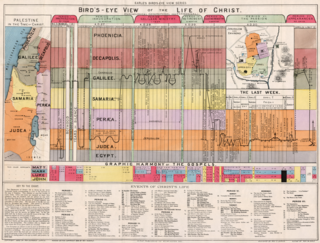
A chronology of Jesus aims to establish a timeline for the events of the life of Jesus. Scholars have correlated Jewish and Greco-Roman documents and astronomical calendars with the New Testament accounts to estimate dates for the major events in Jesus's life.

Jesus, also referred to as Jesus Christ, Jesus of Nazareth, and many other names and titles, was a first-century Jewish preacher and religious leader. He is the central figure of Christianity, the world's largest religion. Most Christians believe Jesus to be the incarnation of God the Son and the awaited messiah, the Christ that is prophesied in the Old Testament.
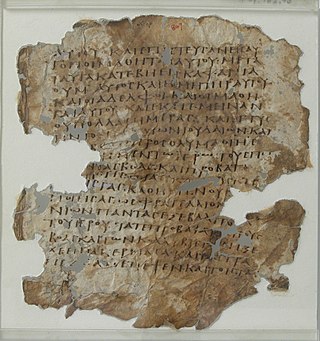
John 2 is the second chapter of the Gospel of John in the New Testament of the Christian Bible. It contains the famous stories of the miracle of Jesus turning water into wine and Jesus expelling the money changers from the Temple. The author of the book containing this chapter is anonymous, but early Christian tradition uniformly affirmed that John composed this gospel.
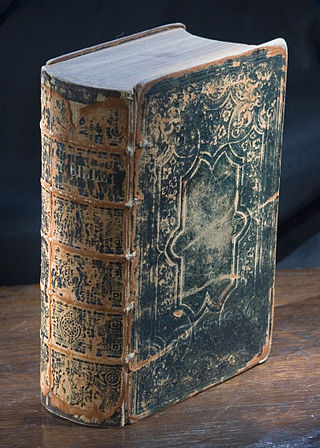
Disputes regarding the internal consistency and textual integrity of the Bible have a long history.

Tiberius Julius Abdes Pantera was a Roman-Phoenician soldier born in Sidon, whose tombstone was found in Bingerbrück, Germany, in 1859.

The ministry of Jesus, in the canonical gospels, begins with his baptism near the River Jordan by John the Baptist, and ends in Jerusalem in Judea, following the Last Supper with his disciples. The Gospel of Luke states that Jesus was "about 30 years of age" at the start of his ministry. A chronology of Jesus typically sets the date of the start of his ministry at around AD 27–29 and the end in the range AD 30–36.
Sefer Toledot Yeshu, often abbreviated as Toledot Yeshu, is a medieval text which presents an alternative, anti-sectarian view, as well as a disputed biography of Jesus of Nazareth. It exists in a number of different versions, none of which is considered either canonical or normative within Rabbinic literature, but which appear to have been widely circulated in Europe and the Middle East in the medieval period. A 15th-century Yemenite version of the text was titled Maaseh Yeshu, or the "Episode of Jesus", in which Jesus is described either as being the son of Joseph or the son of Pandera. The account portrays Jesus as an impostor.

The crucifixion darkness is an event described in the synoptic gospels in which the sky becomes dark in daytime during the crucifixion of Jesus for roughly three hours. Most ancient and medieval Christian writers treated this as a miracle, and believed it to be one of the few episodes from the New Testament which were confirmed by non-Christian sources. Modern scholars have found no contemporary references to it outside the New Testament.
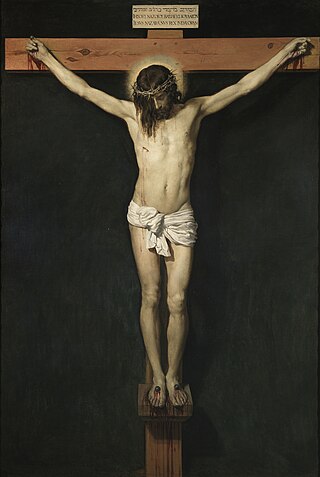
The crucifixion of Jesus was the execution by crucifixion of Jesus of Nazareth in 1st-century Judaea, most likely in AD 30 or AD 33. It is described in the four canonical gospels, referred to in the New Testament epistles, later attested to by other ancient sources, and is broadly accepted as one of the events most likely to have occurred during his life. There is no consensus among historians on the details.

The triumphal entry into Jerusalem is a narrative in the four canonical Gospels describing the arrival of Jesus in Jerusalem a few days before his crucifixion. This event is celebrated each year by Christians on Palm Sunday.
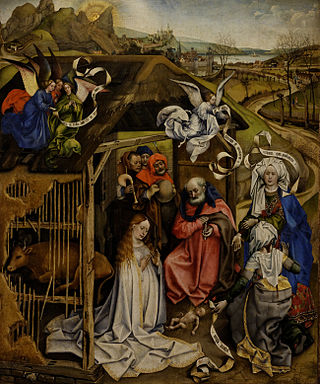
The date of the birth of Jesus is not stated in the gospels or in any historical sources and the evidence is too incomplete to allow for consistent dating. However, most biblical scholars and ancient historians believe that his birth date is around 4 to 6 BC. Two main approaches have been used to estimate the year of the birth of Jesus: one based on the accounts in the Gospels of his birth with reference to King Herod's reign, and the other by subtracting his stated age of "about 30 years" when he began preaching.
In Christianity, the title Son of God refers to the status of Jesus as the divine son of God the Father.







